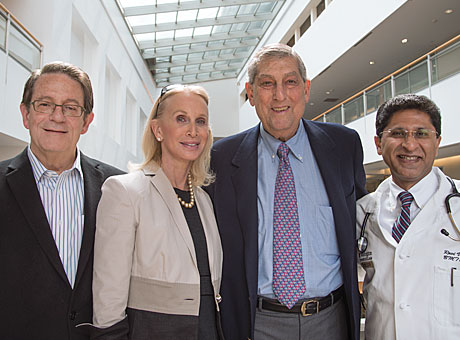
Linda and Harvey Saligman, center, support the multiple myeloma research of John F. DiPersio, MD, PhD, left, and Ravi Vij, MD.

Linda and Harvey Saligman, center, support the multiple myeloma research of John F. DiPersio, MD, PhD, left, and Ravi Vij, MD.
Wanting to make a difference in the fight against cancer, Harvey Saligman and his wife, Linda, saw an ideal opportunity. Diagnosed with multiple myeloma seven years ago, Saligman discovered that even though his disease was one of the most common types of blood cancer (lymphoma and leukemia among them), most research dollars went to other types of cancer.
“I’m convinced that this particular cancer can be cured,” Saligman says. “We wanted to accelerate that time frame by supporting research efforts.”
The Harvey and Linda Saligman Multiple Myeloma Research Fund, established in 2009, is paying dividends in terms of cancer research accomplishments. In the past year, two new drugs have received federal approvals to treat multiple myeloma, both the result of clinical trials in which Washington University was a leading research site.
The university also has established a large myeloma tissue bank for ongoing research and is a member of the Multiple Myeloma Research Consortium — 13 U.S. academic centers focused on speeding the development of new therapies.
“Thanks to support from the Saligmans, we’ve been able to get a critical mass of basic science researchers to focus on this disease and broaden our multifaceted effort to study the biology of multiple myeloma,” says Ravi Vij, MD, associate professor of medicine in the Division of Oncology. “It also enables us to conduct clinical trials, which are leading to new medications, such as the two that were recently approved.”
“We’ve already made great strides in improving the life expectancy of patients with multiple myeloma by helping to find new therapies as a result of this gift,” says Division of Oncology Chief John F. DiPersio, MD, PhD, the Virginia E. and Sam J. Golman Professor of Medicine in Oncology.
“It is so exciting to see the young scientists who actually are doing this work,” says Linda Saligman. “Because of their efforts, there is hope. Now that some of the research is also focused on the potential inherited aspect of this disease, there is hope for generations to come.”
Adds Harvey Saligman, “I’ve seen unbelievable advances in myeloma research here. The best part about going public about our own experience with this disease is that hopefully it will attract other people to give so that the momentum we have going can really make a difference.”